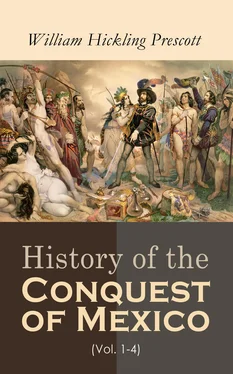[194]According to Gama (Descripcion, Parte 1, pp. 75, 76), because 369 can be divided by nine without a fraction; the nine “companions” not being attached to the five complementary days. But 4, a mystic number much used in their arithmetical combinations, would have answered the same purpose equally well. In regard to this, McCulloh observes, with much shrewdness, “It seems impossible that the Mexicans, so careful in constructing their cycle, should abruptly terminate it with 360 revolutions, whose natural period of termination is 2340.” And he supposes the nine “companions” were used in connection with the cycles of 260 days, in order to throw them into the larger ones, of 2340; eight of which, with a ninth of 260 days, he ascertains to be equal to the great solar period of 52 years. (Researches, pp. 207, 208.) This is very plausible. But in fact the combinations of the two first series, forming the cycle of 260 days, were always interrupted at the end of the year, since each new year began with the same hieroglyphic of the days. The third series of the “companions” was intermitted, as above stated, on the five unlucky days which closed the year, in order, if we may believe Boturini, that the first day of the solar year might have annexed to it the first of the nine “companions,” which signified “lord of the year” (Idea, p. 57); a result which might have been equally well secured, without any intermission at all, by taking 5, another favorite number, instead of 9, as the divisor. As it was, however, the cycle, as far as the third series was concerned, did terminate with 360 revolutions. The subject is a perplexing one, and I can hardly hope to have presented it in such a manner as to make it perfectly clear to the reader.
[195]Hist. de Nueva-España, lib. 4, Introd.
[196]“Dans les pays les plus différents,” says Benjamin Constant, concluding some sensible reflections on the sources of the sacerdotal power, “chez les peuples de mœurs les plus opposées, le sacerdoce a dû au culte des éléments et des astres un pouvoir dont aujourd’hui nous concevons à peine l’idée.” De la Religion (Paris, 1825), lib. 3, ch. 5.
[197]
“It is a gentle and affectionate thought.
That, in immeasurable heights above us,
At our first birth the wreath of love was woven
With sparkling stars for flowers.”
Coleridge: Translation of Wallenstein, act 2, sc. 4.
Schiller is more true to poetry than history, when he tells us, in the beautiful passage of which this is part, that the worship of the stars took the place of classic mythology. It existed long before it.
[198]Gama has given us a complete almanac of the astrological year, with the appropriate signs and divisions, showing with what scientific skill it was adapted to its various uses. (Descripcion, Parte 1, pp. 25-31, 62-76.) Sahagun has devoted a whole book to explaining the mystic import and value of these signs, with a minuteness that may enable one to cast up a scheme of nativity for himself. (Hist. de Nueva-España, lib. 4.) It is evident he fully believed the magic wonders which he told. “It was a deceitful art,” he says, “pernicious and idolatrous, and was never contrived by human reason.” The good father was certainly no philosopher.
[199]See, among others, the Cod. Tel.-Rem., Part 4, Pl. 22, ap. Antiq. of Mexico, vol. i.
[200]“It can hardly be doubted,” says Lord Kingsborough, “that the Mexicans were acquainted with many scientific instruments of strange invention, as compared with our own; whether the telescope may not have been of the number is uncertain; but the thirteenth plate of M. Dupaix’s Monuments , Part Second, which represents a man holding something of a similar nature to his eye, affords reason to suppose that they knew how to improve the powers of vision.” (Antiq. of Mexico, vol. vi. p. 15, note.) The instrument alluded to is rudely carved on a conical rock. It is raised no higher than the neck of the person who holds it, and looks—to my thinking—as much like a musket as a telescope; though I shall not infer the use of fire-arms among the Aztecs from this circumstance. (See vol. iv. Pl. 15.) Captain Dupaix, however, in his commentary on the drawing, sees quite as much in it as his lordship. Ibid., vol. v. p. 241.
[201]Gama, Descripcion, Parte 1, sec. 4; Parte 2, Apend.—Besides this colossal fragment, Gama met with some others, designed, probably, for similar scientific uses, at Chapoltepec. Before he had leisure to examine them, however, they were broken up for materials to build a furnace,—a fate not unlike that which has too often befallen the monuments of ancient art in the Old World.
[202][For additional light upon the Mexican astronomical and calendar system and the “calendar stone,” easily accessible authors are: Bandelier, Archæological Tour, Peabody Museum Reports, ii. 572; Valentini, American Antiquarian Society Proceedings, April, 1878; Squier, Some New Discoveries respecting Dates on the Great Calendar Stone, etc.; American Journal of Science and Arts, Second Series, March, 1849; Bancroft, Native Races, ii. chap. 16 and v. p. 192; Short, North Americans of Antiquity, chap, ix.; Wilson, Prehistoric Man, i; Brasseur, Chronologie historiques des Méxicaines, in Actes de la Soc. d’Ethnographie, vol vi.; Payne, New World Called America, ii. 310 seq. Mrs. Nuttall claims that this calendar stone stood in the great market-place in Mexico, and that its purpose was to regulate the market-days.—M.]
[203]In his second treatise on the cylindrical stone, Gama dwells more at large on its scientific construction, as a vertical sun-dial, in order to dispel the doubts of some sturdy skeptics on this point. (Descripcion, Parte 2, Apend. 1.) The civil day was distributed by the Mexicans into sixteen parts, and began, like that of most of the Asiatic nations, with sunrise. M. de Humboldt, who probably never saw Gama’s second treatise, allows only eight intervals. Vues des Cordillères, p. 128.
[204]“Un calendrier,” exclaims the enthusiastic Carli, “qui est réglé sur la révolution annuelle du soleil, non-seulement par l’addition de cinq jours tous les ans, mais encore par la correction du bissextile, doit sans doute être regardé comme une opération déduite d’une étude réfléchie, et d’une grande combinaison. Il faut donc supposer chez ces peuples une suite d’observations astronomiques, une idée distincte de la sphère, de la déclinaison de l’écliptique, et l’usage d’un calcul concernant les jours et les heures des apparitions solaires.” Lettres Américaines, tom. i. let. 23.
[205]La Place, who suggests the analogy, frankly admits the difficulty. Système du Monde, lib. 5, ch. 3.
[206]M. Jomard errs in placing the new fire , with which ceremony the old cycle properly concluded, at the winter solstice. It was not till the 26th of December, if Gama is right. The cause of M. Jomard’s error is his fixing it before, instead of after, the complementary days. See his sensible letter on the Aztec calendar, in the Vues des Cordillères, p. 309.
[207]At the actual moment of their culmination, according to both Sahagun (Hist. de Nueva-España, lib. 4, Apend.) and Torquemada (Monarch. Ind., lib. 10, cap. 33, 36). But this could not be, as that took place at midnight, in November, so late as the last secular festival, which was early in Montezuma’s reign, in 1507. (Gama, Descripcion, Parte 1, p. 50, nota.—Humboldt, Vues des Cordillères, pp. 181, 182.) The longer we postpone the beginning of the new cycle, the greater must be the discrepancy.
[208]
“On his bare breast the cedar boughs are laid;
On his bare breast, dry sedge and odorous gums,
Laid ready to receive the sacred spark,
And blaze, to herald the ascending Sun,
Upon his living altar.”
Читать дальше












